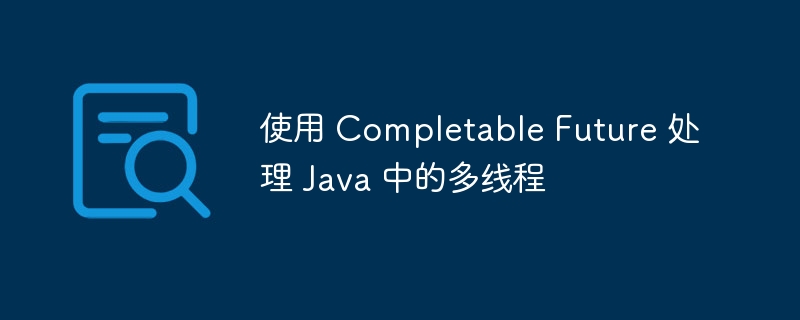使用 Completable Future 处理 Java 中的多线程
来源:dev.to
时间:2024-09-09 11:13:06 312浏览 收藏
欢迎各位小伙伴来到golang学习网,相聚于此都是缘哈哈哈!今天我给大家带来《使用 Completable Future 处理 Java 中的多线程》,这篇文章主要讲到等等知识,如果你对文章相关的知识非常感兴趣或者正在自学,都可以关注我,我会持续更新相关文章!当然,有什么建议也欢迎在评论留言提出!一起学习!

1. 理解完整的未来
completablefuture 是 java.util.concurrent 包的一部分,提供了一种以更具可读性和可维护性的方式编写异步、非阻塞代码的方法。它代表异步计算的未来结果。
1.1 创建一个简单的completablefuture
从 completablefuture 开始,您可以创建一个简单的异步任务。这是一个例子:
import java.util.concurrent.completablefuture;
public class completablefutureexample {
public static void main(string[] args) {
completablefuture<void> future = completablefuture.runasync(() -> {
system.out.println("running asynchronously...");
// simulate a long-running task
try {
thread.sleep(2000);
} catch (interruptedexception e) {
e.printstacktrace();
}
});
future.join(); // wait for the task to complete
system.out.println("task completed.");
}
}
- completablefuture.runasync() 异步执行任务。
- future.join() 阻塞主线程,直到任务完成。
演示结果:
running asynchronously... task completed.
1.2 将 completablefuture 与结果结合使用
您还可以使用completablefuture返回异步任务的结果:
import java.util.concurrent.completablefuture;
public class completablefuturewithresult {
public static void main(string[] args) {
completablefuture<integer> future = completablefuture.supplyasync(() -> {
// simulate a computation
return 5 * 5;
});
future.thenaccept(result -> {
system.out.println("the result is: " + result);
}).join();
}
}
- completablefuture.supplyasync() 用于返回结果的任务。
- thenaccept() 计算完成后处理结果。
演示结果:
the result is: 25
2. 组合多个completablefuture
处理多个异步任务是一个常见的用例。 completablefuture 提供了多种组合 future 的方法。
2.1 将 future 与 thencombine 结合起来
您可以组合多个 completablefutures 的结果:
import java.util.concurrent.completablefuture;
public class combiningfutures {
public static void main(string[] args) {
completablefuture<integer> future1 = completablefuture.supplyasync(() -> 5);
completablefuture<integer> future2 = completablefuture.supplyasync(() -> 10);
completablefuture<integer> combinedfuture = future1.thencombine(future2, (result1, result2) -> result1 + result2);
combinedfuture.thenaccept(result -> {
system.out.println("combined result: " + result);
}).join();
}
}
- thencombine () 组合两个 future 的结果。
- 使用 thenaccept () 处理组合结果。
演示结果:
combined result: 15
2.2 使用 allof 处理多个 future
当需要等待多个 future 完成时,使用 completablefuture.allof():
import java.util.concurrent.completablefuture;
public class allofexample {
public static void main(string[] args) {
completablefuture<void> future1 = completablefuture.runasync(() -> {
// simulate task
try {
thread.sleep(1000);
} catch (interruptedexception e) {
e.printstacktrace();
}
});
completablefuture<void> future2 = completablefuture.runasync(() -> {
// simulate another task
try {
thread.sleep(2000);
} catch (interruptedexception e) {
e.printstacktrace();
}
});
completablefuture<void> alloffuture = completablefuture.allof(future1, future2);
alloffuture.join();
system.out.println("all tasks completed.");
}
}
- completablefuture.allof() 等待所有给定的 future 完成。
- join() 确保主线程等待,直到所有任务完成。
演示结果:
all tasks completed.
3. completablefuture 的错误处理
处理错误在异步编程中至关重要。 completablefuture 提供了管理异常的方法。
3.1 使用异常处理异常
使用异常()处理异步任务中的异常:
import java.util.concurrent.completablefuture;
public class exceptionhandlingexample {
public static void main(string[] args) {
completablefuture<integer> future = completablefuture.supplyasync(() -> {
throw new runtimeexception("something went wrong!");
}).exceptionally(ex -> {
system.out.println("exception occurred: " + ex.getmessage());
return null;
});
future.join();
}
}
- 异常 () 捕获并处理异常。
- 它允许您提供后备结果或处理错误。
演示结果:
Exception occurred: Something went wrong!
4.completablefuture的优缺点
4.1 优点
- 异步执行:高效处理并发运行的任务,而不阻塞主线程。
- 提高了可读性:与传统的回调方法相比,提供了一种更具可读性和可维护性的方式来处理异步代码。
- 丰富的 api :提供多种方法来组合、处理和组合多个 future。
4.2 缺点
- 复杂性:completablefuture 虽然功能强大,但会在管理和调试异步代码时引入复杂性。
- 异常处理:处理异常有时可能很棘手,尤其是在具有多个阶段的复杂场景中。
5. 结论
在本指南中,我们探索了如何使用 completablefuture 处理 java 中的并发请求。从创建简单的异步任务到组合多个 future 和处理错误,completablefuture 提供了一种健壮且灵活的异步编程方法。
如果您有任何疑问或需要进一步帮助,请随时在下面发表评论。我很乐意提供帮助!
阅读更多帖子:使用 completable future 处理 java 中的多线程
到这里,我们也就讲完了《使用 Completable Future 处理 Java 中的多线程》的内容了。个人认为,基础知识的学习和巩固,是为了更好的将其运用到项目中,欢迎关注golang学习网公众号,带你了解更多关于的知识点!
-
501 收藏
-
501 收藏
-
501 收藏
-
501 收藏
-
501 收藏
-
276 收藏
-
479 收藏
-
282 收藏
-
134 收藏
-
220 收藏
-
162 收藏
-
215 收藏
-
491 收藏
-
114 收藏
-
354 收藏
-
117 收藏
-
254 收藏
-

- 前端进阶之JavaScript设计模式
- 设计模式是开发人员在软件开发过程中面临一般问题时的解决方案,代表了最佳的实践。本课程的主打内容包括JS常见设计模式以及具体应用场景,打造一站式知识长龙服务,适合有JS基础的同学学习。
- 立即学习 543次学习
-

- GO语言核心编程课程
- 本课程采用真实案例,全面具体可落地,从理论到实践,一步一步将GO核心编程技术、编程思想、底层实现融会贯通,使学习者贴近时代脉搏,做IT互联网时代的弄潮儿。
- 立即学习 516次学习
-

- 简单聊聊mysql8与网络通信
- 如有问题加微信:Le-studyg;在课程中,我们将首先介绍MySQL8的新特性,包括性能优化、安全增强、新数据类型等,帮助学生快速熟悉MySQL8的最新功能。接着,我们将深入解析MySQL的网络通信机制,包括协议、连接管理、数据传输等,让
- 立即学习 500次学习
-

- JavaScript正则表达式基础与实战
- 在任何一门编程语言中,正则表达式,都是一项重要的知识,它提供了高效的字符串匹配与捕获机制,可以极大的简化程序设计。
- 立即学习 487次学习
-

- 从零制作响应式网站—Grid布局
- 本系列教程将展示从零制作一个假想的网络科技公司官网,分为导航,轮播,关于我们,成功案例,服务流程,团队介绍,数据部分,公司动态,底部信息等内容区块。网站整体采用CSSGrid布局,支持响应式,有流畅过渡和展现动画。
- 立即学习 485次学习
